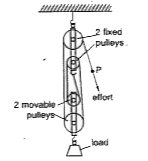Answer true or false:
If the efficiency of a machine is 100%, the mechanical advantage equals the velocity ratio.
To determine whether the statement "If the efficiency of a machine is 100%, the mechanical advantage equals the velocity ratio" is true or false, we can follow these steps:
Step 1: Understand the Definitions
- Efficiency (η) of a machine is defined as the ratio of useful work output to the total work input, usually expressed as a percentage.
- Mechanical Advantage (MA) is the ratio of the output force produced by the machine to the input force applied.
- Velocity Ratio (VR) is the ratio of the distance moved by the effort (input distance) to the distance moved by the load (output distance).
Step 2: Analyze the Condition of 100% Efficiency
- When a machine has 100% efficiency, it means that all the input work is converted into output work without any losses due to friction or other factors. Thus, the work output equals the work input.
Step 3: Relate Efficiency to Mechanical Advantage and Velocity Ratio
- The formula for efficiency can be expressed as:
Efficiency(η)=Mechanical Advantage (MA)Velocity Ratio (VR)
- If the efficiency is 100%, then:
1=MAVR
- This implies that:
MA=VR
Step 4: Conclusion
- Since we have established that when the efficiency of a machine is 100%, the mechanical advantage equals the velocity ratio, we can conclude that the statement is True.
Final Answer
True
---
- Efficiency (η) of a machine is defined as the ratio of useful work output to the total work input, usually expressed as a percentage.
- Mechanical Advantage (MA) is the ratio of the output force produced by the machine to the input force applied.
- Velocity Ratio (VR) is the ratio of the distance moved by the effort (input distance) to the distance moved by the load (output distance).
- When a machine has 100% efficiency, it means that all the input work is converted into output work without any losses due to friction or other factors. Thus, the work output equals the work input.
- The formula for efficiency can be expressed as:
Efficiency(η)=Mechanical Advantage (MA)Velocity Ratio (VR)
- If the efficiency is 100%, then:
1=MAVR
- This implies that:
MA=VR
- Since we have established that when the efficiency of a machine is 100%, the mechanical advantage equals the velocity ratio, we can conclude that the statement is True.
True
Similar Questions
Knowledge Check
Efficiency of Carnot engine is 100% if
AT2=273KBT2=0KCT1=273KDT1=0KEfficiency of Carnot engine is 100% if
Asing is at0∘CBsink is at 0KCsource is at 273∘CDsource is at 100∘CFor an ideal machine the ratio of mechanical advantage (MA) to the velocity ratio (VR) is:
Agreater than oneBless than oneCequal to oneDdependent on the value of load
Answer true or false:
If a plane is inclined at a steeper angle, its mechanical advantage increases.
View SolutionCan the efficiency of heat engine be 100% ? Justify
View SolutionWhat is the ratio between mechanical advantage and velocity ratio of an ideal machine.
View SolutionIn the following figure :

What is the efficiency of this pulley system if the mechanical advantage is 3?
View SolutionThe thermal efficiency of a heat engine will be 100% when
View Solution
